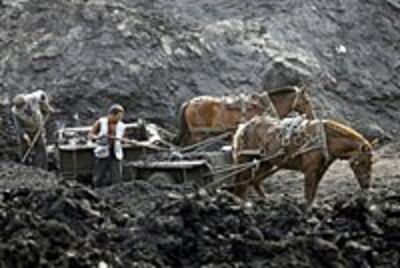
China has postponed plans to close all small coal mines by the end of 2007, citing opposition from local governments. Despite deadly accidents and pollution concerns, Beijing now plans to shut fewer than half the mines by 2010.
In April, Zhao Tiechui, director of the State Administration of Coal Mine Safety, ordered all mines with annual production of less than 30,000 tons to shut down by the end of 2007, China’s official news agency Xinhua reported at the time.
Zhao cited government figures showing that while China’s small mines produce 38 percent of the country’s coal, they account for three-quarters of the country’s fatal mining accidents.
But on Oct. 13, the official China Daily reported that "after meeting opposition from local governments, the central government has been forced to postpone the plan until 2010."
After meeting opposition from local governments, the central government has been forced to postpone the plan until 2010.
China Daily
In interviews with Radio Free Asia, energy and environmental experts said the government seems to be seeking new ways to exert authority over the sector in hopes of achieving its goals.
Migrant laborers involved
Philip Andrews-Speed, a China energy expert at Scotland’s University of Dundee, said that in some cases mine owners employ migrant labor and are interested only in their income from the mines. In other cases, mines provide local jobs that can be hard to replace.
“There are areas where the small coal miners are indeed locals, where they need the employment as well as the economic activity,” Andrews-Speed said. “And there are other areas where they actually need the coal, because it’s a long way from anywhere and it’s difficult to get coal in.”
A plan to merge small mines into larger operations could keep the facilities open by simply reorganizing them on paper. But Andrews-Speed said the plan could be beneficial if it leads to more efficient management.
“If you’ve got a hill with a different number of groups mining into the hill from different directions, then it actually makes a great deal of sense from the point of view of mining engineering, safety, environmental management, and many other things, to bring all those mines under one management and then produce a consolidated production plan for that deposit.”
Andrews-Speed added that larger mining companies could be better organized to raise money, buy new equipment, and promote safety training with improved technology. The risk is that larger companies could have greater political power to resist safety reforms.
Jennifer Turner, coordinator of the China Environment Forum at the Washington-based Woodrow Wilson International Center for Scholars, said “it actually could go either way.”
“There are now stricter laws on violations, pollution spills, and major pollution accidents, and [this] makes it easier to go after the head of a bigger corporation than many of these small ones,” Turner said.
“It could be a good model, and they’ve run out of options.”
Reports of delays in the shutdown of small mines may be unusual in themselves, since they point openly to local resistance to central government regulation, Turner said.
“It’s admirable, actually that they are admitting this weakness. At the same time, it could be a signal that they going to start devoting more resources to it.”
Andrews-Speed said that in the past, reports have surfaced long after the fact that small mines that were supposed to be closed were still open and running. But this may be the first time that the official press has disclosed the delay of a shutdown target in advance.
“They are prepared to admit that the closure campaign in its current phase is going more slowly than they’d expected, which has happened before, but this is the first they’ve admitted it at the time of the campaign,” Andrews-Speed said.
“So you could say this is a step forward in at least transparency.”
Original reporting by Michael Lelyveld. Edited for the Web by Richard Finney.
